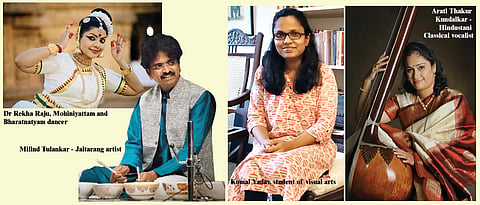

Meditation and mindfulness have become the latest buzzwords as people are constantly living in stressful surroundings. Spiritual leaders, mental health experts and motivational speakers are seen promoting various meditation practices to people. Meditation, the ancient method of relaxation, is about observing thoughts and feelings without any judgements or feelings. It focuses more on getting healthy perspective which will help in better self understanding. Anyone who follows meditation regularly, will definitely see drastic changes in themselves. In fact, even a few minutes of silence in the morning can help in setting the day right.
DANCE IS TRANCE
For some though, exactly the same results can be found in their respective passion, like the arts. The reason is that performing arts use concepts like presence, stillness, awareness and peacefulness which are integral to the former too. The process of creating art is considered to be therapeutic as it is the powerful form of expression and self-healing process in the artist. And it is not important to be an expert to enjoy the process, mere involvement of the person is enough to stay centred.
Dr Rekha Raju, a Bharatanatyam and Mohiniyattam dancer, points out that initially in every dance form, students go through a process called Saadhana which is a kind of meditation but involves movements of the head, eyes and the body. “When the performer is performing, the dance itself becomes meditation. While performing, the artist’s body, mind and soul are in a trance, which means the performer is only thinking of the god s/he is performing for. Natyashastra, the treatise on performing arts, also mentions that while performing, there is a connect between atma and paramatma.”
Raju explains that once an artist gets into the feelings and emotions of the dance, s/he can convey them to the audience as well. “In every class, we teach students Namaskaramwhich is a prayer primarily for Lord Shiva and the Guru. The prayers bring the spiritual aspect and when we the teach shlokas like Gurur Brahma, Gurur Vishnu,it marks our surrendering to the God of Dance, but starting from the Guru. Students might not understand these spiritual aspects initially but it is important to introduce them to it nonetheless,” she adds.
EXPRESSION IS THERAPEUTIC
After the prayer comes the expression. As health writer, editor, and content producer Paula Ford- Martin has correctly said, “Art therapy, sometimes called expressive art or art psychology, encourages self-discovery and emotional growth. It is a two-part process, involving both the creation of art and the discovery of its meaning.”
Taking this thread, Komal Yadav, a second year student of visual arts at Sir J J Arts College, says that she finds painting meditative. “The joy lies in the process of making the art even if you do not get it correct all the time. This process keeps me centred in the present moment. It has helped me do everything more consciously. Gaining a meditative state comes with involvement in something one loves doing. Art certainly helps me to connect with myself. I look for patterns within and around me that help me put my artworks in a way that what is on my mind is projected."
Arati Thakur Kundalkar, a classical singer, feels that meditation in any form is for the self and there need not be any time limit to be in the meditative state. “I feel people meditate to be silent from within. Also, I feel as an artist, even when I am performing or listening to any piece of music by my Guru or even by other legends like Lata Mangeshkar, I can sense that meditative feel within. What matters is the amount of attention I give to listening to that piece of music. When I do my riyaz in the morning, I experience an inner peace. I need not sit for meditation separately." she says and adds, “While performing, if I am able to feel the music, it reaches the audience naturally. Meditation is completely for the self and it must be felt within primarily for attaining peace and it can be done through art, music or yoga."
INSTRUMENTS OF PEACE
Meditation and instrumental music is a magical combination, which creates a calmer environment. For an instrumental artist, getting into a meditative state is a natural process, says Milind Tulankar, one of the finest Jaltarang artists around. “While playing the Jaltarang, by default, I get into the state of meditation, it is an involuntary process. Once we are in that stage, everything flows easily in terms of music. Even while practising, I do not feel like taking up calls or look at others. It becomes easy to disconnect from the outer world once you get involved with music. I also work on music therapy in different hospitals which helps me connect with different people,” he says.
He recalls how he performed for 11 days at a stretch once but did not feel stressed. “I had been to France and Belgium where I had to perform for 11 days with 14 shows but I did not feel tired or stressed about it. On the contrary, my co-artists and I were ready to give more shows. It is because of the joy we get out of the art. Hence, it is said that music helps in attaining the higher self.”
Meditation, is considered to be a way of connecting with your own self, while disconnecting with the outside world and involving in art is a form of meditation too.
